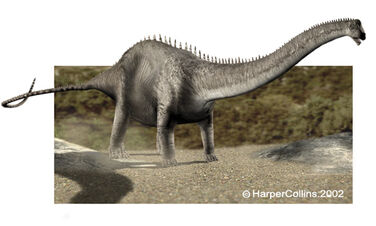Diplodocus was a long-necked, whip-tailed giant, measuring about 110 feet (33 m) long with a 30 foot (9 m) long neck and a 50 foot (15.5 m) long tail, but its head was less than 2 feet long. It was among the longest land animals ever.

Description[]
Its nostrils were at the top of its head and it had peg-like teeth, but only in the front of the jaws. Its front legs were shorter than its back legs, and all had elephant-like, five-toed feet. One toe on each foot had a thumb claw, probably for protection. A fossilized Diplodocus skin impression reveals that it had a row of spines running down its back.Diplodocus was more lightly built than the other giant sauropods, and may have weighed only about 10-20 tons. Its backbone had extra bones underneath it, which had bony protrusions running both forwards and backwards (anvil shaped), a "double beam", probably for support and extra mobility of its neck and tail. It may have used its whip-like tail for protection. A recent Diplodocus skin impression was found, showing a row of spines running down the back.
It has been determined that Diplodocus (and the other diplodocid sauropods, like Apatosaurus) could not hold their necks over about 17 feet (5.4 m) off the ground (Parrish and Stevens,1999).
Gastralia (hanging belly ribs) are thin, fragile ribs that helped support and protect the internal organs (like the lungs) in the middle area of the body. These ribs were not attached to the backbone; they were attached to the skin in the belly area. Diplodocus was an herbivore (it ate only plants). It must have eaten a tremendous amount of plant material each day to sustain itself. It swallowed leaves whole, without chewing them, and may have swallowed gastroliths (stones that remained in its stomach) to help digest this tough plant material. It had blunt teeth, useful for stripping foliage.
Its main food was probably conifers, which were the dominant plant when the large sauropods lived. Secondary food sources may have included gingkos, seed ferns, cycads, bennettitaleans, ferns, club mosses, and horsetails.
Diplodocus held its neck more-or-less horizontally (parallel to the ground). The long neck may have been used to poke into forests to get foliage that was otherwise unavailable to the huge, lumbering varieties of sauropods who could not venture into forests because of their size. Alternatively, the long neck may have enabled this sauropod to eat soft pteridophytes (horsetails, club mosses, and ferns). These soft-leaved plants live in wet areas, where sauropods couldn't venture, but perhaps the sauropod could stand on firm ground and browse in wetlands. Diplodocus may have travelled in herds, migrating when the local food supply was depleted. Diplodocus probably hatched from eggs, like other sauropods.Sauropod eggs have been found in a linear pattern and not in nests; presumably the eggs were laid as the animal was walking. It is thought that sauropods did not take care of their eggs. Sauropod life spans may have been on the order of 100 years.Diplodocus moved slowly on four column-like legs (as determined from fossilized tracks and its leg length and estimated mass).
Diplodocus lived in the late Jurassic Period, from 155-145 million years ago. The late Jurassic was the time of the enormous sauropods, including Camarasaurus, Apatosaurus, and Brachiosaurus. Also present were Stegosaurus, Tuojiangosaurus, Allosaurus, Supersaurus, Coelurosaur, and many others.
The first Diplodocus fossil was found by Earl Douglass and Samuel W. Williston in 1877 and was named by paleontologist Othniel C. Marsh in 1878. Many Diplodocus fossils have been found in the Rocky Mountains of the western USA (in Colorado, Montana, Utah, and Wyoming). Diplodocus means "Double-beamed."